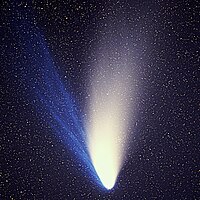
Photo from wikipedia
Abstract Comet nuclei and D-type asteroids have several similarities at optical and near-IR wavelengths, including near-featureless red reflectance spectra, and low albedos. Mineral identifications based on these characteristics are fraught… Click to show full abstract
Abstract Comet nuclei and D-type asteroids have several similarities at optical and near-IR wavelengths, including near-featureless red reflectance spectra, and low albedos. Mineral identifications based on these characteristics are fraught with degeneracies, although some general trends can be identified. In contrast, spectral emissivity features in the mid-infrared provide important compositional information that might not otherwise be achievable. Jovian Trojan D-type asteroids have emissivity features strikingly similar to comet comae, suggesting that they have the same compositions and that the surfaces of the Trojans are highly porous. However, a direct comparison between a comet and asteroid surface has not been possible due to the paucity of spectra of comet nuclei at mid-infrared wavelengths. We present 5–35 µm thermal emission spectra of comets 10P/Tempel 2, and 49P/Arend-Rigaux observed with the Infrared Spectrograph on the Spitzer Space Telescope. Our analysis reveals no evidence for a coma or tail at the time of observation, suggesting the spectra are dominated by the comet nucleus. We fit each spectrum with the near-Earth asteroid thermal model (NEATM) and find sizes in agreement with previous values. However, the NEATM beaming parameters of the nuclei, 0.74–0.83, are systematically lower than the Jupiter-family comet population mean of 1.03 ± 0.11, derived from 16- and 22-µm photometry. We suggest this may be either an artifact of the spectral reduction, or the consequence of an emissivity low near 16 µm. When the spectra are normalized by the NEATM model, a weak 10-µm silicate plateau is evident, with a shape similar to those seen in mid-infrared spectra of D-type asteroids. A silicate plateau is also evident in previously published Spitzer spectra of the nucleus of comet 9P/Tempel 1. We compare, in detail, these comet nucleus emission features to those seen in spectra of the Jovian Trojan D-types (624) Hektor, (911) Agamemnon, and (1172) Aneas, as well as those seen in the spectra of seven comet comae. The comet comae present silicate features with two distinct shapes, either trapezoidal, or more rounded, the latter apparently due to enhanced emission near 8 to 8.5 µm. The surfaces of Tempel 2, Arend-Rigaux, and Hektor best agree with the comae that present trapezoidal features, furthering the hypothesis that the surfaces of these targets must have high porosities in order to exhibit a spectrum similar to a comet coma. An emissivity minimum at 15 µm, present in the spectra of Tempel 2, Arend-Rigaux, Hektor, and Agamemnon, is also described, the origin of which remains unidentified. The compositional similarity between D-type asteroids and comets is discussed, and our data supports the hypothesis that they have similar origins in the early Solar System.
Journal Title: Icarus
Year Published: 2017
Link to full text (if available)
Share on Social Media: Sign Up to like & get
recommendations!